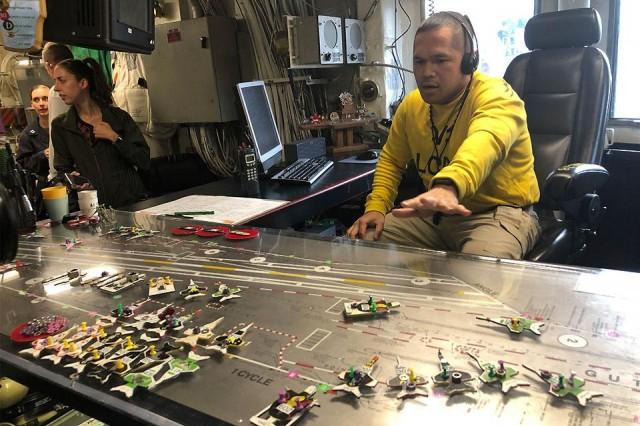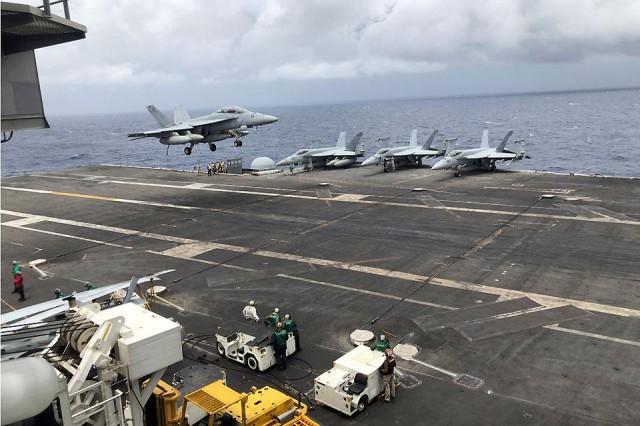Filipinos shine aboard one of the most powerful US warships
Senior Chief Jonard Sygaco hovers over a glass-covered metal plate representing the USS Ronald Reagan’s flight deck. Behind him, through reinforced glass windows, men scurry around an F18-E Superhornet fighter jet as it makes its way to the end of one of the three catapult launch areas. Steam rises from the catapult track as the huge fighter jet is coaxed into place.
The nuclear-powered aircraft carrier is launching fighter jets and surveillance planes as it sailed through the West Philippine Sea, an hour's flight from Manila.
There are other men in the room with Sygaco, clad in green, yellow, blue, and violet. The colored uniforms classify the men according to their specific flight deck duties. Sygaco wears the yellow of those charged with the movement of aircraft across the busy flight deck.

He pushes cardboard cutouts of F18 jets, helicopters and other aircraft across the deck, colored pins and bolts indicating launch order and operational status of each aircraft beneath the top board. Another deck full of aircraft cutouts mirror the aircraft positions within the cavernous bowels of the hangar bay.
Sygaco slides an F18 on the number 2 catapult area to the side of the board, as the aircraft it represents thundered past the windows and over the turbulent waters of the West Philippine Sea.
"We call this the Ouija board. But I run the airplanes across it, not ghosts or spirits," he jokes.
Sygaco is just one of the Filipino-Americans serving on board, arguably, one of the most powerful warships in the whole world. Elsewhere inside the massive warship, more than 200 other Filipinos call the USS Reagan their home at sea.
From aircraft mechanics, machinists and cooks, the Filipinos are present in just about every aspect of the ship's operations. Some of the crew members we talked to enlisted in the Navy right after high school.
For Ensign Patrick Bolton, however, choosing the Navy was somewhat of a family tradition. A graduate of the of the US Naval Academy at Maryland, Bolton's father was a Naval Aviator who was stationed in Subic Bay. Bolton’s mother hails from Cavite province.
"Navy din si Papa so he influenced me to join the Navy and so here I am today," he says in a mix of Filipino and English. "Kaga-graduate ko lang po ng Naval Academy sa Maryland so dito wardroom officer po ako."
The Filipino 'mafia'
We meet the other Filipino servicemen inside the hangar bay just below the flight deck. They nod and smile, throwing an occasional "Kamusta po?" at us. Left on their own, they gather under the shadow of an F18 and giggle among themselves, taking the odd selfie and photo with the Filipino journalists who had come aboard.
Within the US Armed Forces, Filipinos have a reputation for sticking together and helping each other — a unique camaraderie some servicemen have jokingly referred to as the Filipino Mafia.
On board the USS Reagan, that spirit is alive as well.
"Everybody is like, 'Oh hi, kuya ate.' Just like that. The moment that we see them coming in we are like, 'Hey, how are you? Where you coming from? Where you born at? Can you speak Tagalog?' Basically it's just like a group of regular friends," says Ryan De Guzman, one of the senior servicemen.
"Whether you are a coconut or not we're still a strong bond," says machinist, Javelyn Acosta, referring to Fiipino-American who cannot speak the mother tongue.
"Yung coconut is brown on the outside but white on the inside. Your brown kasi Filipino ka, but white kasi we speak English and don't really speak Tagalog," she adds.
Tensions at sea
Amid the escalating trade war between the US and China and bellicose political rhetoric thrown from both sides, crew members say they can't help but feel the tension as their ship sails through waters heavily patrolled by China.
We spot the outline of a military ship on the horizon and point them out to one of the crew members. He squints at the ship, shielding his eyes from the sun.

"Nope. That's not American," he says.
A few minutes later, US warships that were escorting the Battlforce 7th Fleet flagship come into view.
A Philippine military official present during the tour of the aircraft carrier tells reporters that around four Chinese warships had sailed alongside the USS Ronald Reagan as it made its way to the port of Manila.
But for the officers of the Battleforce 7th Fleet, all encounters with the Chinese Navy have so far been very professional.
"The most important thing is that we can operate in the same body of water, communicate with one another and there is no misunderstanding," says Rear Admiral Karl Thomas, commander of the Battleforce 7th Fleet based out of Okinawa Japan.
While the Americans and Chinese have an understanding on how to communicate with each other in the high seas, both nations are still at odds on the US Freedom of Navigation Operations or FONOPS. China has repeatedly shown its displeasure at the presence of US warships near its artificial islands in the West Philippine Sea.
"We intend to sail, operate and fly wherever international law allows," Thomas says. —KBK, GMA News



